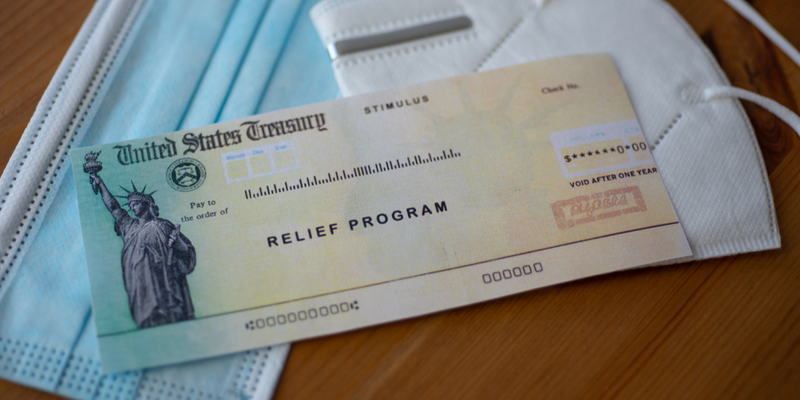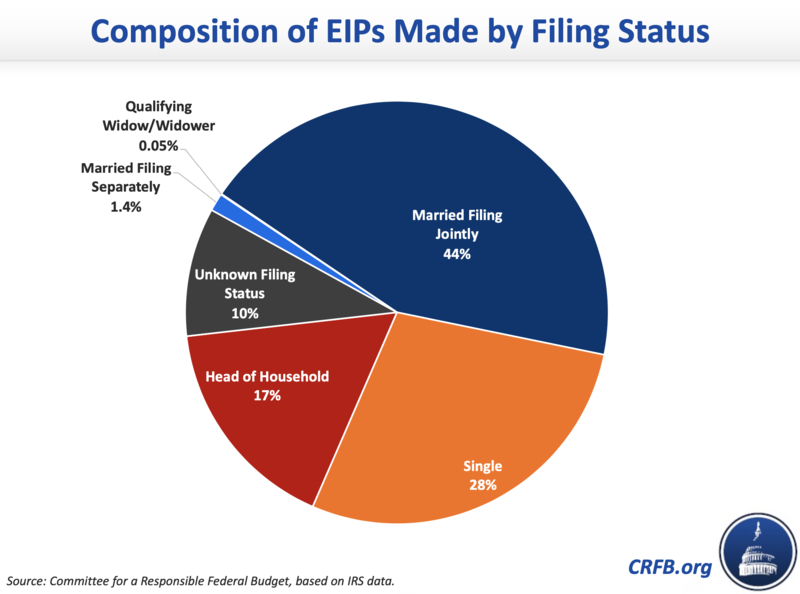Stimulating the Economy: An Analysis of the Economic Impact Payments
"Economic Impact Payments are an important part of our efforts to provide relief to families and workers during this crisis." - Nancy Pelosi
Brief Insight
Economic Impact Payments (EIPs) are payments made by the U.S. government to individuals to provide financial relief during times of economic hardship. They were first introduced in 2008 and have been used in response to the COVID-19 pandemic. Eligibility for EIPs is based on factors such as income, filing status, and citizenship status, with most individuals eligible to receive up to $1,400 per person.

PHOTO: https://www.abipcpa.com
What are EIPs?
Economic Impact Payments (EIPs), also known as stimulus payments or stimulus checks, are direct payments made by the US federal government to eligible individuals and families in order to provide financial assistance during times of economic hardship. The purpose of these payments is to inject money into the economy and provide support for those who are struggling financially due to circumstances such as job loss, reduced hours, or other economic impacts.
EIPs have been issued during several different economic crises, including the COVID-19 pandemic and the 2008 financial crisis. The amount of the payment varies based on a number of factors, including income level, family size, and other eligibility criteria. The payments are typically issued as a one-time lump sum and are intended to provide immediate financial relief to recipients.
EIPs are an important tool for policymakers to help support economic recovery during times of crisis. By providing direct financial assistance to those who need it most, EIPs can help stimulate spending and support economic growth. However, the effectiveness of these payments in achieving these goals depends on a number of factors, including the size and scope of the program, the eligibility criteria, and the broader economic conditions in which the payments are issued.
Interesting Facts about Economic Impact Payments
The first round of Economic Impact Payments was issued in 2008 as part of the Economic Stimulus Act in response to the global financial crisis.
The second round of Economic Impact Payments was issued in 2020 as part of the Coronavirus Aid, Relief, and Economic Security (CARES) Act in response to the COVID-19 pandemic.
The third round of Economic Impact Payments was issued in 2021 as part of the American Rescue Plan, which included $1,400 payments to eligible individuals.
The History of Economic Impact Payments
The concept of direct payments to individuals during times of economic hardship has been used in the United States for many years, but the specific program known as Economic Impact Payments (EIPs) was created as a response to the 2020 COVID-19 pandemic.
In March 2020, the Coronavirus Aid, Relief, and Economic Security (CARES) Act was passed by the US Congress and signed into law by President Trump. The CARES Act included provisions for the creation of Economic Impact Payments, which provided direct payments of up to $1,200 to eligible individuals and $2,400 to eligible couples, with an additional $500 for each qualifying child.
Since the creation of EIPs in the CARES Act, additional rounds of stimulus payments have been issued, including the December 2020 Consolidated Appropriations Act and the March 2021 American Rescue Plan Act. These payments have provided further economic relief to individuals and families impacted by the COVID-19 pandemic.

PHOTO: www.oaklandca.gov
Understanding the Financing of Economic Impact Payments
Economic Impact Payments (EIPs) are funded through a combination of government appropriations and federal borrowing.
The funds for the first round of EIPs, which were issued as part of the Coronavirus Aid, Relief, and Economic Security (CARES) Act, were appropriated by the US Congress. These funds came from a variety of sources, including the Coronavirus Relief Fund, which provided $150 billion in direct aid to state and local governments, and the Paycheck Protection Program and Health Care Enhancement Act, which provided additional funding for small business loans and healthcare programs.
Subsequent rounds of EIPs have been funded through a combination of government appropriations and federal borrowing. For example, the December 2020 Consolidated Appropriations Act provided $600 stimulus payments to eligible individuals, while the March 2021 American Rescue Plan Act provided $1,400 payments.
In order to finance these payments, the federal government has borrowed money through the issuance of Treasury bonds and other debt instruments. This borrowing increases the national debt, which is the total amount of money owed by the federal government. While borrowing can be a useful tool for financing government programs, it can also have long-term economic consequences, such as higher interest rates and inflation.
Interesting Facts about Economic Impact Payments
Over 160 million Economic Impact Payments were issued during the first round of payments in 2020, totaling over $270 billion.
Administering Economic Impact Payments: How Stimulus Checks Are Distributed
Economic Impact Payments (EIPs) are administered by the Internal Revenue Service (IRS), which is the agency responsible for collecting taxes and issuing tax refunds in the United States.
The IRS uses information from individuals' tax returns to determine their eligibility for EIPs and to calculate the amount of their payment. For the first round of EIPs issued as part of the CARES Act, the IRS used 2018 or 2019 tax return information to determine eligibility and payment amounts. For subsequent rounds of EIPs, the IRS may have used more recent tax return information.
The IRS typically distributes EIPs via direct deposit into recipients' bank accounts, although paper checks and debit cards may also be used for those who do not have bank accounts on file with the IRS. The timing of EIP distribution can vary depending on a number of factors, including the volume of payments being processed and the accuracy of individuals' tax return information.
Individuals who did not receive an EIP or who believe they received an incorrect payment amount can contact the IRS for assistance. The IRS has set up a dedicated website and phone line for EIP-related inquiries and has provided guidance on how to claim missing or incorrect payments.

PHOTO: www.crfb.org
Services Provided by Economic Impact Payments: Financial Relief for Americans
Economic Impact Payments (EIPs) provide direct financial assistance to eligible individuals and families during times of economic hardship. The payments are intended to provide immediate relief and support for those who are struggling financially due to circumstances such as job loss, reduced hours, or other economic impacts.
EIPs can help individuals and families cover essential expenses such as housing, food, and healthcare, as well as discretionary spendings such as entertainment and leisure activities. By providing this financial support, EIPs can help stimulate spending and support economic growth, particularly in industries that have been hit hardest by the economic impacts of the COVID-19 pandemic, such as hospitality, tourism, and retail.
In addition to providing direct financial support, EIPs can also help alleviate financial stress and anxiety for those who are struggling to make ends meet. This can have broader positive impacts on mental health and well-being, which in turn can support broader economic and social outcomes.
Overall, the services provided by EIPs are intended to support economic recovery and provide immediate relief to individuals and families impacted by economic hardship. However, the effectiveness of these payments in achieving their intended goals depends on a range of factors, including the broader economic context in which they are issued and the eligibility criteria used to determine payment amounts.
Interesting Facts about Economic Impact Payments
The second and third rounds of Economic Impact Payments were issued to a smaller number of individuals but still provided significant financial support to millions of Americans.
Advantages of Economic Impact Payments: Providing Financial Support in Times of Need
Economic Impact Payments (EIPs) provide a number of advantages and benefits to individuals and families who are facing financial hardship. Some of the key advantages and benefits of EIPs include
- Immediate financial relief: EIPs provide direct financial assistance to eligible individuals and families, which can help them cover essential expenses such as food, housing, and healthcare. This immediate relief can be particularly important for those who have lost their jobs or experienced reduced income due to economic downturns, as it can help them stay afloat financially and avoid falling into debt or financial distress.
- Economic stimulus: By providing direct financial assistance to individuals and families, EIPs can also help stimulate spending and support economic growth. This is particularly important during times of economic hardship, as increased spending can help support struggling industries and businesses, create jobs, and support broader economic recovery.
- Reduction in poverty and inequality: EIPs can also help reduce poverty and inequality by providing direct financial support to those who need it most. By targeting payments to individuals and families with lower incomes, EIPs can help address income disparities and reduce the number of individuals living in poverty or struggling to make ends meet.
- Positive impacts on mental health and well-being: EIPs can also have positive impacts on mental health and well-being by reducing financial stress and anxiety. By providing individuals and families with greater financial stability and security, EIPs can help reduce stress and improve overall mental health outcomes.
- Support for social safety net programs: Finally, EIPs can also help support broader social safety net programs by providing additional financial support to individuals and families who may also be eligible for other forms of government assistance, such as unemployment benefits, Medicaid, or SNAP (Supplemental Nutrition Assistance Program).
Overall, the advantages and benefits of EIPs are significant and can help support individuals and families facing financial hardship, stimulate economic growth, and address broader issues of poverty and inequality. However, the effectiveness of these payments in achieving their intended goals depends on a range of factors, including the broader economic context in which they are issued and the eligibility criteria used to determine payment amounts.

https://unsplash.com/@igalness
Disadvantages of Economic Impact Payments: Limitations and Criticisms
While Economic Impact Payments (EIPs) have a number of advantages and benefits, there are also several disadvantages and limitations to consider. Some of the key disadvantages and limitations of EIPs include:
- Limited coverage: EIPs are targeted at specific groups of individuals and families, which means that many people may not be eligible to receive them. For example, non-citizens, dependents, and individuals without a Social Security number may be excluded from receiving EIPs.
- Limited impact: EIPs may not be enough to fully address the financial needs of individuals and families facing economic hardship. Depending on the size of the payments and the severity of the economic downturn, EIPs may not provide enough financial support to help individuals and families cover essential expenses or avoid falling into debt.
- Unequal distribution: EIPs may also contribute to income inequality by providing larger payments to individuals and families with higher incomes. For example, some rounds of EIPs have provided full payments to individuals with incomes of up to $75,000, but only partial payments or no payments to those with higher incomes. This means that higher-income individuals may receive a larger share of the benefits of EIPs, while lower-income individuals may receive relatively less support.
- Dependence on government action: EIPs are dependent on government action, which means that they may be subject to delays, changes, or interruptions depending on political and economic circumstances. For example, subsequent rounds of EIPs have been delayed or reduced in size due to political disagreements over the scope and size of government spending.
- Potential for fraud and abuse: EIPs may also be vulnerable to fraud and abuse, as some individuals may attempt to claim payments that they are not entitled to receive. This can result in wasted government resources and may divert payments away from individuals and families who need them most.
Overall, while EIPs can provide important financial support to individuals and families facing economic hardship, they also have several limitations and disadvantages that need to be considered. Policymakers and stakeholders must carefully evaluate the effectiveness of EIPs in achieving their intended goals, and identify ways to address the limitations and disadvantages of these payments.
Interesting Facts about Economic Impact Payments
The eligibility requirements for Economic Impact Payments have evolved over time, with the American Rescue Plan expanding eligibility to include some non-citizen residents and dependents over the age of 16.
Economic Impact Payments Eligibility: Who is Eligible and How to Qualify
The eligibility criteria for Economic Impact Payments (EIPs) vary depending on the specific round of payments and the legislation authorizing them. However, there are some general guidelines that have applied to most rounds of EIPs:
- Tax filing status: Eligible individuals must have a valid Social Security number and must have filed a tax return for the relevant tax year unless they are exempt from filing a return.
- Income: Eligibility for EIPs is generally based on income level. The specific income thresholds and phase-out limits have varied depending on the round of payments. For example, the first round of EIPs issued as part of the CARES Act provided full payments of up to $1,200 for individuals with adjusted gross income (AGI) of up to $75,000 ($150,000 for married couples filing jointly), with reduced payments for individuals with higher incomes, and no payments for individuals with AGI above certain thresholds.
- Age: Eligible individuals must be at least 18 years old unless they are qualifying children.
- Residency: Eligible individuals must be US citizens or resident aliens.
- Other factors: Eligibility may also depend on other factors, such as whether the individual is claimed as a dependent on someone else's tax return, whether they owe back taxes or other debts to the government, and whether they are incarcerated.
It is important to note that the specific eligibility criteria and payment amounts for EIPs can vary depending on the round of payments and the legislation authorizing them. For example, subsequent rounds of EIPs have provided different payment amounts and income thresholds than the first round issued as part of the CARES Act. Additionally, eligibility criteria and payment amounts can change over time as new legislation is passed or existing programs are modified.

PHOTO: www.kare11.com
Applying for Economic Impact Payments: How to Receive Stimulus Checks
Most individuals do not need to apply for Economic Impact Payments (EIPs) as they are automatically issued by the Internal Revenue Service (IRS) based on their 2019 or 2020 tax returns. However, there are some cases where individuals may need to take additional steps to receive their EIPs or update their payment information. Below are some key steps to apply for EIPs:
- Check eligibility: Before applying for EIPs, it is important to check if you are eligible to receive them. Eligibility for EIPs is based on a number of factors, including income, filing status, and citizenship status. For more information on eligibility requirements, you can visit the IRS website.
- File tax returns: In order to receive EIPs, most individuals need to file a tax return for the relevant year. If you have not filed a tax return for 2019 or 2020, you may need to do so in order to receive your EIP. If you are not required to file a tax return, you may be able to use the IRS Non-Filers tool to provide your information to the IRS.
- Update payment information: If you have changed your address, bank account, or other payment information since you last filed a tax return, you may need to update this information with the IRS in order to receive your EIP. You can use the Get My Payment tool on the IRS website to check the status of your payment and update your payment information.
- Contact the IRS: If you have not received your EIP and believe that you are eligible to receive one, you can contact the IRS for assistance. The IRS has a number of customer service resources available, including a toll-free hotline and online chat service.
Overall, applying for EIPs typically involves filing tax returns, checking eligibility, and updating payment information if necessary. While most individuals do not need to take additional steps to receive their EIPs, it is important to stay informed and take action if you encounter any issues or challenges.
Interesting Facts about Economic Impact Payments
"Economic Impact Payments have provided critical support to millions of families and individuals struggling to make ends meet during this difficult time." - Ron Wyden
- Economic Impact Payments, also known as stimulus checks, are payments made to individuals by the U.S. government in order to provide financial relief during times of economic hardship.
- EIPs were first introduced in 2008 during the financial crisis and have since been used in response to other economic challenges, including the COVID-19 pandemic.
- Eligibility for EIPs is based on a number of factors, including income, filing status, and citizenship status.
- Most individuals do not need to apply for EIPs, as they are automatically issued by the IRS based on tax return information.
- EIPs can provide significant financial support to individuals and families during times of economic hardship, but they also have some limitations and disadvantages.
- If you are eligible for EIPs and have not received them, or need to update your payment information, there are resources available to help you apply and receive your payment.
FAQ
How much will I receive in Economic Impact Payments?
The amount of EIPs that individuals receive depends on a number of factors, including their income and filing status. In general, individuals can receive up to $1,400 per person.
Do I need to apply for Economic Impact Payments?
Most individuals do not need to apply for EIPs, as they are automatically issued by the IRS based on tax return information. However, there are some cases where individuals may need to take additional steps to receive their payments.
When will I receive my Economic Impact Payment?
The timing of EIPs can vary depending on a number of factors, including the IRS processing time and the method of payment. In general, most individuals can expect to receive their payment within a few weeks of the IRS processing their tax return.
Can I receive Economic Impact Payments if I owe taxes?
Yes, individuals who owe taxes can still receive EIPs. However, EIPs can be offset by any taxes owed or other federal debts.
Are Economic Impact Payments taxable?
No, EIPs are not considered taxable income and do not need to be reported on tax returns.
What should I do if I have not received my Economic Impact Payment?
If you have not received your EIP and believe that you are eligible to receive one, you can contact the IRS for assistance. The IRS has a number of customer service resources available, including a toll-free hotline and online chat service